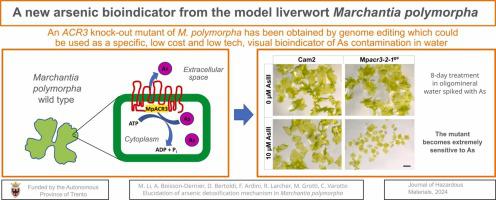当前位置:
X-MOL 学术
›
J. Hazard. Mater.
›
论文详情
Our official English website, www.x-mol.net, welcomes your feedback! (Note: you will need to create a separate account there.)
Elucidation of arsenic detoxification mechanism in Marchantia polymorpha: The role of ACR3
Journal of Hazardous Materials ( IF 13.6 ) Pub Date : 2024-03-19 , DOI: 10.1016/j.jhazmat.2024.134088 Mingai Li , Aurélien Boisson-Dernier , Daniela Bertoldi , Francisco Ardini , Roberto Larcher , Marco Grotti , Claudio Varotto
Journal of Hazardous Materials ( IF 13.6 ) Pub Date : 2024-03-19 , DOI: 10.1016/j.jhazmat.2024.134088 Mingai Li , Aurélien Boisson-Dernier , Daniela Bertoldi , Francisco Ardini , Roberto Larcher , Marco Grotti , Claudio Varotto

|
The arsenic-specific ACR3 transporter plays pivotal roles in As detoxification in yeast and a group of ancient tracheophytes, the ferns. Despite putative genes being present in the genomes of bryophytes, whether they have the same relevance also in this lineage is currently unknown. In this study, we characterized the Mp gene from the bryophyte L. through a multiplicity of functional approaches ranging from phylogenetic reconstruction, expression analysis, loss- and gain-of-function as well as genetic complementation with an Mp gene tagged with a fluorescent protein. Genetic complementation demonstrates that Mp plays a pivotal role in As tolerance in , with loss-of-function Mp mutants being hypersensitive and Mp overexpressors more tolerant to As. Additionally, MpACR3 activity regulates intracellular As concentration, affects its speciation and controls the levels of intracellular oxidative stress. The MpACR3::3xCitrine appears to localize at the plasma membrane and possibly in other endomembrane systems. Taken together, these results demonstrate the pivotal function of ACR3 detoxification in both sister lineages of land plants, indicating that it was present in the common ancestor to all embryophytes. We propose that Mp mutants could be used in developing countries as low-cost and low-technology visual bioindicators to detect As pollution in water.
更新日期:2024-03-19



























 京公网安备 11010802027423号
京公网安备 11010802027423号